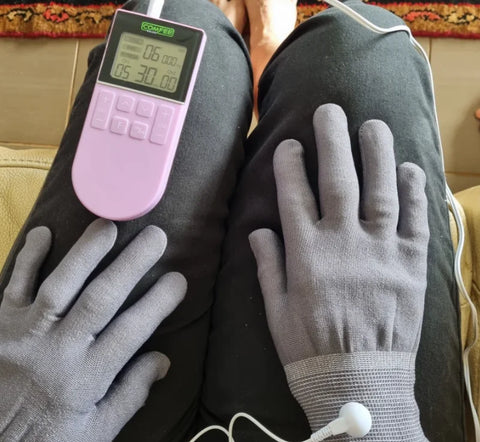Has your physiotherapist recommended using TENS or EMS devices? Or perhaps someone close to you has talked about the incredible results they found with one of these electrical treatments?
TENS and EMS devices are frequently used to deal with ongoing pain, but they're often confused as the same thing. Despite both using electrical currents, they serve different purposes and offer distinct treatment capabilities. To put it simply, TENS might be better for immediate relief, but for a lasting solution that improves muscle function, EMS could be the way forward.
In this blog post, we'll explore TENS vs EMS to help you decide which one is right for you. Remember to always consult with a healthcare professional before introducing any new treatment regimen to your body.
What are TENS and EMS?
TENS and EMS, short for Transcutaneous Electrical Nerve Stimulation and Electrical Muscle Stimulation, both use electrical currents but have different goals. Understanding the nuances of the TENS vs EMS debate can help you determine which electrotherapy device best suits your type of pain.
TENS aims to ease pain by sending gentle electrical pulses through the skin, potentially blocking pain signals to the brain. On the other hand, EMS focuses on stimulating muscles directly, causing them to contract. Unlike TENS, EMS isn't primarily used for pain relief. Instead, its best use case is making muscles stronger while improving movement.
Choosing the Right Device: TENS vs EMS
Choosing between TENS and EMS essentially boils down to which purposes they serve. TENS targets pain relief by working on nerves and interrupting pain signals. On the other hand, EMS focuses on muscles, helping with strength, recovery, and rehabilitation.
Picking the right one means matching their functions to your needs. So, it's all about choosing the device that best fits what you're aiming for in terms of health and recovery goals.
Factors to Consider When Choosing a Device
When evaluating TENS vs EMS, start by exploring the type of neuromuscular stimulation required for your condition, the device's features, and any recommendations from healthcare professionals.
If pain management is the priority, TENS could be the right choice. For muscle stimulation targeting strength or rehabilitation, EMS might be more suitable. Evaluate your goals to find the device that aligns with your goals.
Medical Conditions and Contraindications
Before settling between TENS vs EMS, consider any existing medical conditions and risk factors. Specific health issues like cardiac pacemakers, pregnancy and epilepsy could impact the effectiveness of any muscle stimulation technology. Consulting with a medical professional can clear up any doubts you may have.
Cost and Insurance Coverage
Consider the cost and insurance coverage, as they can be decisive factors. TENS and EMS units come at different prices; not all insurance plans cover them.
Take the time to understand the costs involved and check with your insurance provider to know the extent of your coverage.
User-friendliness and Portability
Finally, the device's ease of use and portability can influence your choice between TENS vs EMS. Whether a simple TENS unit or a more complex EMS system, it should be hassle-free and seamlessly fit into your lifestyle without causing complications.

Combining TENS and EMS: Enhanced Benefits
TENS and EMS devices create a powerful combo for managing pain and improving muscle condition. This dual-faceted technique has recently gained traction among professionals as a formidable tool in physical therapy modalities.
Potential Benefits of Using Both TENS and EMS
Pairing TENS and EMS into your pain management regimen offers a comprehensive approach. TENS tackles pain by blocking pathways to the brain, while EMS strengthens muscles through contractions.
Aside from alleviating pain, this combo promotes muscle health as a multifaceted option for relief and rejuvenation.
Combining Pain Relief and Muscle Recovery
The blend of TENS and EMS takes a two-pronged approach: TENS tackles nerve pain, while EMS aids muscle healing by improving blood flow and strengthening muscles. This combo can reduce reliance on medication and improve overall muscle function, speeding up recovery naturally.
Combining Rehabilitation and Performance Enhancement
When it comes to rehabilitation and performance enhancement, combining TENS and EMS proves highly effective. This electric stimulation therapy duo heals injured muscles and prepares them for future challenges.
Athletes and those in physical therapy benefit by improving muscle tone and performance and getting pain relief at the same time.
Bottom Line
In the matchup of TENS vs EMS, the right choice boils down to your specific needs in pain management techniques. TENS is your frontline defense against persistent pain, disrupting pain signals before they reach the brain. EMS targets muscle repair and strength, which is for recovery or athletic training.
The good news? Comfee Relief provides devices that combine both TENS and EMS. This means you don't have to pick sides in the TENS vs EMS showdown.
Instead, you get a tailored approach to pain relief and muscle conditioning, all from one trusted source. So, whether it's soothing pain or boosting muscle health, Comfee Relief has your back — literally!
